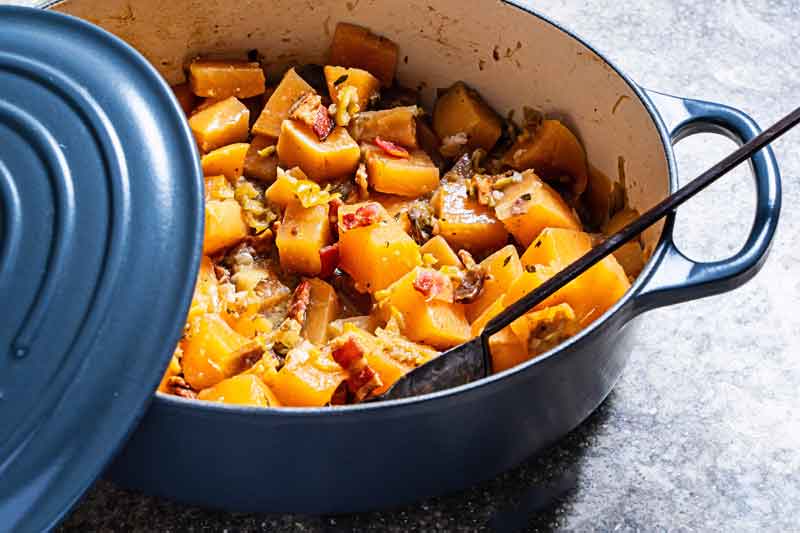 Scott Suchman for The Washington Post
Scott Suchman for The Washington Post
When it comes to cooking vegetables, braising is rarely front of mind. Particularly during the colder months, I love employing this method to turn tough cuts of meat into silken morsels of pure delight. Yet when it comes to vegetables, I tend to prefer a dry heat cooking method, like sauteing or roasting, to get some nice browning and enhance the food's natural flavor.
But on second thought, many of the Southern vegetable dishes I was raised on are braises. Braised cabbage has the word in its name; Southern-style greens, such as collards, mustard or turnip, often fit this categorization as well (depending on the amount of liquid used); and one of my favorites, candied sweet potatoes, is the epitome of what braising can produce.
Whether you're new to braising vegetables or are looking to revisit recipes from your past, here's everything you need to know about how to turn your next haul of produce into a masterpiece.
• What is braising?
Braising is a technique that involves gently cooking food partially submerged in liquid in a covered cooking vessel, either in the oven or on the stove, until tender. The beauty of the braise is that the item being cooked and the liquid in which it's cooked infuse each other with flavor, the two once disparate components melding into one.
• What to braise
Personally, I'm a fan of braising tougher vegetables, like those belonging to the genus brassica (Brussels sprouts, cabbage and rutabagas). Alliums - onions and shallots and leeks, oh my! - are also excellent cooked in this manner. In theory, you can braise practically anything, even more delicate items, such as asparagus and peas. However, I would stay away from soft and liquidy vegetables, such as tomatoes (though botanically fruits), because they're likely to just turn into a sauce.
• How to braise
Before you begin, you need to prep your vegetables. Scrub anything you wish to keep with the peel intact with a produce brush (i.e. carrots and radishes), and peel and trim everything else as desired. Depending on size - and how much time you have - vegetables can be left whole or cut into smaller pieces.
When braising an animal protein, the first step is almost always to sear it in a hot skillet until nicely browned all over to start building flavor. When it comes to vegetables, the initial browning step is optional, and in some cases not appropriate.
Consider your braising liquid. Outside of the produce itself, the second most integral part of the braise is the liquid in which said produce is cooked. What you choose to use, of course, depends on the desired outcome. Want a light, clean taste? Water will do the trick. Looking for a bit of fruit and acidity? Grab a bottle of wine. In search of some umami? Mushroom, chicken or beef stock are your friends. Other liquids, such as cider, beer and milk, are also up for grabs, and all can be used solo or in combination with others.
The amount of liquid you'll need comes down to geometry. (And no, you don't need to use the Pythagorean theorem - your eyes will do just fine.) In general, you want to pour enough liquid into the cooking vessel to come up to about one-third the height of the vegetables. You might need a little more or less depending on the vegetable's density and moisture content, but this is a good place to start.
(For braised cabbage, for example, I tend to rely primarily on the moisture within the cabbage itself with little to no additional liquid.)
If you take a peak during the cooking and things look a little dry, you can always add more liquid; conversely, if your vegetables are tender but look like they're swimming, just remove the lid and reduce it down to an amount more to your liking.
Choose how to flavor your braise. For this step, you need to consider what spices, aromatics, fats (which can also lend the braising liquid a velvety texture) and other seasonings will play well with and enhance the vegetables and liquid you've chosen. There are countless paths you can take, but a good way to approach constructing your recipe is to think about which flavor profile levers (salt, umami, spice, sweet, sour and bitter) you want to pull up and down.
Now it's time to cook. Cover the pot with a tight-fighting lid or enclose the pot with parchment and foil, bring the braise to a slow simmer - this can either be done on the stove on medium-low heat or in the oven around 325 degrees - and cook until tender. One's desired level of tenderness is a deeply personal choice, similar to whether you prefer smooth or chunky peanut butter. I like just the slightest bit of resistance when the vegetable is pierced with a fork; that way you don't have to work too hard to chew, but it's not the texture of baby food.
Once the vegetables are to your desired level of doneness, the final decision you have to make is what to do with the braising liquid. You can keep things simple and leave the dish nice and brothy, bring it to a boil with the lid off to cook it down almost completely until it forms a glaze to coat each morsel, or aim for a consistency somewhere in between.
(COMMENT, BELOW)


 Contact The Editor
Contact The Editor
 Articles By This Author
Articles By This Author